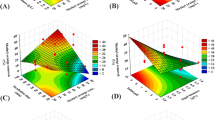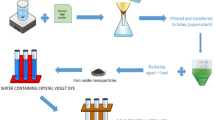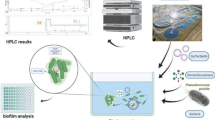Abstract
The discharge of hexavalent chromium [Cr(VI)] has resulted in significant pollution because of the presence of Cr(VI) oxyanions. They are highly water-soluble, cell-permeable and transportable in water sources. To eliminate the toxic effects, various chemical and biological methods have been developed. Bioremediation can be used as an effective tool over conventional chemical processes for the removal of toxic hexavalent chromium species. Blue-green algae-mediated bioremediation is gaining more interest due to its availability and efficiency. In this method, [Cr(VI)] is reduced to relatively less toxic [Cr(III)] as a consequence of oxidation of organic components present in the water extract of wall algae. The percent removal of Cr(VI) is increased by the addition of the anionic surfactant sodium dodecyl sulfate (SDS) and the neutral surfactant Triton-X-100 (TX-100). It was found that the percent removal efficiency of unanalyzed, TX-100 and SDS catalyzed (3 × 10−2 M) systems are approximately 47, 54 and 80 %, respectively, in 8 days. The efficiency of these systems increases with the increase in the equivalent amount of added surfactant (3 × 10−1 M). The reaction proceeds to almost completion (96 %) with the increase in the added surfactant (3 × 10−1 M). The optimum pH of the reaction was found to be 2 and the temperature 40 °C. The amount of Cr(III) formed was measured by the fluorescence technique with a known dye selective to Cr(III), and the presence of soluble Cr(VI) in the mixture was estimated by a diphenylcarbazide kit. This method was further used to determine the removal efficiency of the SDS-catalyzed system in collected [Cr(VI)]-contaminated water sources, i.e. a pond beside the Sukinda valley in Cuttack, India, and pond water from the local area, sea water from Cuttack and Digha, W.B., India, as well as from the tanning industry. All the observations were recorded using UV–Vis, fluorescence and FTIR spectrophotometry.














Similar content being viewed by others
References
D.V. Nica, M. Bura, I. Gergen, M. Harmanescu, D.M. Bordean, Bioaccumulative and conchological assessment of heavy metal transfer in a soil-plant-snail food chain. Chem. Cent. J. 6, 55 (2012)
S. Lewicki, R. Zdanowski, M. Krzyżowska, A. Lewicka, B. Dębski, M. Niemcewicz, M. Goniewicz, The role of Chromium III in the organism and its possible use in diabetes and obesity treatment. Ann. Agric. Environ. Med. 21, 331–335 (2014)
D. Ghosh, B. Bhattacharya, B. Mukherjee, B. Manna, M. Sinha, J. Chowdhury, S. Chowdhury, Role of chromium supplementation in Indians with type 2 diabetes mellitus. J. Nutr. Biochem. 13, 690–697 (2002)
R. Codd, C.T. Dillon, A. Levina, P.A. Lay, Studies on the genotoxicity of chromium: from the test tube to the cell. Coord. Chem. Rev. 216–217, 537–582 (2001)
M. Costa, Potential hazards of hexavalent chromate in our drinking water. Toxicol. Appl. Pharmacol. 188, 1–5 (2003)
R. Saha, R. Nandi, B. Saha, Sources and toxicity of hexavalent chromium. J. Coord. Chem. 64, 1782–1806 (2011)
A.P. Das, S. Mishra, Hexavalent Chromium (VI): environment pollutant and health hazard. J. Environ. Res. Dev. 2, 386–392 (2008)
A. Baral, R.D. Engelken, Chromium based regulation and greening in metal finishing industries in the USA. Environ. Sci. Policy 5, 121–133 (2002)
S.A. Chand, V.K. Aggarwal, P. Kumar, Removal of Hexavelent Chromium from the Wastewater by Adsorption. Indian J. Environ. Health 36, 151–158 (1994)
S. Chakrabarti, B. Chaudhuri, S. Bhattacharjee, A.K. Ray, B.K. Dutta, Photo-reduction of hexavalent chromium in aqueous solution in the presence of zinc oxide as semiconductor catalyst. Chem. Eng. J. 153, 86–93 (2009)
G. Crini, Recent developments in polysaccharide-based materials used as adsorbents in wastewater treatment. Prog. Polym. Sci. 30, 38–70 (2005)
G.P. Haight, E. Perchonock, F. Emmenegger, G. Gordon, The mechanism of the oxidation of sulphur(IV) by chromium(VI) in acid solution. J. Am. Chem. Soc. 87, 3835–3840 (1965)
T. Olmetz, The optimization of Cr(VI) reduction and removal by electrocoagulation using response surface methodology. J. Hazard. Mater. 162, 1371–1378 (2009)
M. Rivero-Huguet, W.D. Marshall, Influence of various organic molecules on the reduction of hexavalent chromium mediated by zero-valent iron. Chemosphere 76, 1240–1248 (2009)
S.K. Sahu, P. Meshram, B.D. Pandey, V. Kumar, T.R. Mankhand, Removal of chromium(III) by cation exchange resin, Indion 790 for tannery waste treatment. Hydrometallurgy 99, 170–174 (2009)
M. Wazne, S.C. Jagupilla, D.H. Moon, S.C. Jagupilla, C. Christodoulatos, M.G. Kim, Assessment of calcium polysulfide for the remediation of hexavalent chromium in chromite ore processing residue (COPR). J. Hazard. Mater. 143, 620–628 (2007)
P. Yuan, D. Liu, M. Fan, D. Yang, R. Zhu, F. Ge, J. Zhu, H. He, Removal of hexavalent chromium [Cr(VI)] from aqueous solutions by the diatomite-supported/unsupported magnetite nanoparticles. J. Harzard. Mater. 173, 614–621 (2009)
Y. Sahin, A. Öztürk, Biosorption of chromium(VI) ions from aqueous solution by the bacterium Bacillus thuriengensis. Process Biochem. 40, 1895–1901 (2005)
K. Vijayaraghavan, Y.-S. Yun, Bacterial biosorbents and biosorption. Biotechnol. Adv. 26, 266–291 (2008)
R. Saha, K. Mukherjee, I. Saha, A. Ghosh, S.K. Ghosh, B. Saha, Removal of hexavalent chromium from water by adsorption on mosambi (Citrus limetta) peel. Res. Chem. Intermed. 39, 2245–2257 (2013)
R. Saha, I. Saha, R. Nandi, A. Ghosh, A. Basu, S.K. Ghosh, B. Saha, Application of Chattim tree (Devil tree, Alstonia scholaris) saw dust as a biosorbent for removal of hexavalent chromium from aqueous solution. Can. J. Chem. Eng. 91, 814 (2013)
K. Mukherjee, R. Saha, A. Ghosh, S.K. Ghosh, P.K. Maji, B. Saha, Surfactant-assisted bioremediation of hexavalent chromium by use of an aqueous extract of sugar cane bagasse. Res. Chem. Intermed. 40, 1727–1734 (2014)
H.N. Bhatti, M. Amin, Removal of zirconium (IV) from aqueous solution by coriolus versicolor equilibrium and thermodynamic study. Ecol. Eng. 51, 178–180 (2013)
W. Bahafid, H. Sayel, N.T. Joutey, N. El Ghachtouli, Removal mechanism of hexavalent chromium by a novel strain of Pichia anomala isolated from industrial effluents of Fez (Morocco). J. Environ. Sci. Eng. 5, 980–991 (2011)
S. Congeevaram, S. Dhanarani, J. Park, M. Dexilin, K. Thamaraiselvi, Biosorption of chromium and nickel by heavy metal resistant fungal and bacterial isolates. J. Hazard. Mater. 146, 270–277 (2007)
K.K. Kumar, M.K. Prasad, G.V.S. Sarma, C.V.R. Murthy, Biosorption studies for removal of chromium using immobilized marine alga Isochrysis galbana. Indian J. Mar. Sci 35, 263–267 (2006)
R. Nandi, K. Mukherjee, B. Saha, Surfactant assistant enhancement of bioremediation rate for hexavalent chromium by water algae. Biochem. Physiol. 4, 173 (2015). doi:10.4172/2168-9652.1000173
G.J. Puzon, A.R. Roberts, D.M. Kramer, L. Xun, Formation of soluble organo–chromium(III) complexes after chromate reduction in the presence of cellular organics. Environ. Sci. Technol. 39, 2811–2817 (2005)
G.J. Puzon, R.K. Tokala, H. Zhang, D. Yonge, B.M. Peyton, Mobility and recalcitrance of organo-chromium(III) complexes. Chemosphere 70, 2054–2059 (2008)
T. Punnett, E.C. Derrenbacker, The amino acid composition of algal cell walls. J. Gen. Microbiol. 44, 105–114 (1966)
M.M. Allen, R.Y. Stanier, Selective isolation of blue–green algae from water and soil. J. Gen. Microbiol. 51, 203–209 (1968)
A. Ghosh, R. Saha, K. Mukhejee, S.K. Ghosh, S.S. Bhattacharyya, S. Laskar, B. Saha, Selection of suitable combination of nonfunctional micellar catalyst and hetero-aromatic nitrogen base as promoterfor chromic acid oxidation of ethanol to acetaldehyde in aqueous medium at room temperature. Int. J. Chem. Kinet. 45, 175–186 (2013)
K. Mukherjee, R. Saha, A. Ghosh, S.K. Ghosh, B. Saha, Chromium removal technologies. Res. Chem. Intermed. 39, 2267–2286 (2012)
Y. Chen, G. Tang, Q.J. Yu, T. Zhang, Y. Chen, Biosorption properties of hexavalent chromium on to biomass of tobacco-leaf residues. Environ. Technol. 30, 1003–1010 (2009)
W. Wanga, Q. Zenga, M. Li, W. Zheng, D. Christianson, Adsorptive removal of carbon dioxide using polyethyleneimine loaded glass fiber in a fixed bed. Colloids Surf. A 481, 117–124 (2015)
H. Luo, C. Gu, W. Zheng, F. Dai, X. Wang et al., Facile synthesis of novel size-controlled antibacterial hybrid spheres using silver nanoparticles loaded with poly-dopamine spheres. RSC Adv. 5, 13470–13477 (2015)
S. Mallick, S.S. Dash, K.M. Parida, Adsorption of hexavalent chromium on manganese nodule leached residue obtained from NH3–SO2 leaching. J. Colloid Interface Sci. 297, 419–425 (2006)
D. Kratochvil, P. Pimentel, B. Volesky, Removal of trivalent and hexavalent chromium by seaweed biosorbent. Environ. Sci. Technol. 32, 2693–2698 (1998)
P. Miretzky, A.F. Cirelli, Cr(VI) and Cr(III) removal from aqueous solution by raw and modified lignocellulosic materials: a review. J. Hazard. Mater. 180, 1–19 (2010)
Author information
Authors and Affiliations
Corresponding author
Rights and permissions
About this article
Cite this article
Nandi, R., Laskar, S. & Saha, B. Surfactant-promoted enhancement in bioremediation of hexavalent chromium to trivalent chromium by naturally occurring wall algae. Res Chem Intermed 43, 1619–1634 (2017). https://doi.org/10.1007/s11164-016-2719-0
Received:
Accepted:
Published:
Issue Date:
DOI: https://doi.org/10.1007/s11164-016-2719-0




